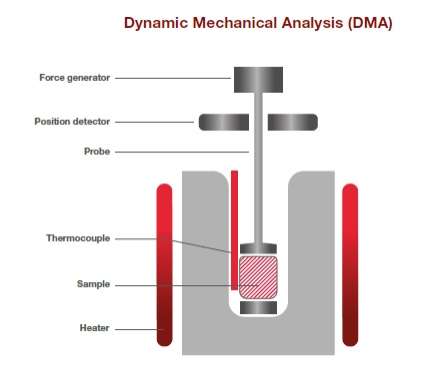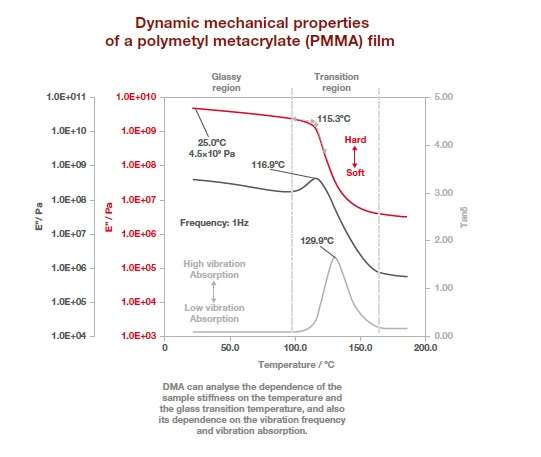DMA (dynamic mechanical analysis) measures the viscoelastic properties of materials, mainly polymers, under oscillating load, (strain or stress) that remains constant over time. Its main use is for glass transition detection, but it can also be used to measure secondary transition, materials stiffness, curing level, and crystallinity.
A sample is clamped in the measurement head of the DMA instrument and a sinusoidal force is applied while the temperature of the sample is changed in a controlled way. The relation between the applied force and the resulting deformation is measured.

Sample properties such as elasticity and viscosity can be calculated from the applied stress and strain plotted as a function of time or temperature.

The DMA output trace above shows the three parameters typically plotted from a DMA measurement.
E’ is the storage or elastic modulus and shows the elastic property of the sample and the degree of the energy stored and recovered against the applied force.
E’’ is the loss or inelastic modulus and shows the viscous property of the sample and degree of the energy transferred to heat against the applied force.
Tanδ is the loss tangent and shows the ratio of E’ to E’’ and reflects the vibration absorbability. It is also called the vibration absorption coefficient or damping.
Fundamentally, these parameters give you information about the changes in stiffness and damping of your polymer over a temperature range.
Dynamic mechanical analysis enables the measurement of stiffness and damping changes when going through a temperature profile and allows the understanding of the effect of temperature on the material physical properties.
The high sensitivity of this technique allows the detection of relaxation phenomena such as glass transition, side-chain relaxation and local mode relaxation can be observed. This approach means information about molecular structure and molecular motion of polymers can be captured.
By performing simultaneous measurement of temperature dispersion and frequency dispersion, the effect of frequency on the material properties and its effect on relaxation transitions can be captured. This means that you can understand the behavior of your materials under the conditions they are intended to be used.
DMA can be used to determine either shear modulus (G) or Young’s modulus (E).
We’ve picked ASTM D4065-20, the standard best practice for plastics: determination and report of procedures. This practice is intended to provide means of determining the transition temperatures, elastic, and loss moduli of plastics over a range of temperatures, frequencies, or time, by free vibration and resonant or non-resonant forced vibration techniques.
Plots of elastic and loss moduli are indicative of the viscoelastic characteristics of a plastic. These moduli are functions of temperature or frequency in plastics and change rapidly at particular temperatures or frequencies. The regions of rapid moduli change are normally referred to as transition regions.
Different modes of deformation, such as tensile, bending and shear, are used, as listed in the referenced test methods.
The DMA thermograms above shows the results for a polymethyl metacrylate (PMMA) film analyzed in tension. The three curves show different information related to the material viscoelastic behaviors. E’ is the storage modulus and gives information about the elastic component of the material which relates to the material stiffness.
The stiffness of the material can be measured at any point, as showed here for the modulus value at 25°C. For amorphous or partly amorphous materials like PMMA, DMA is the perfect technique to detect the glass transition (Tg) as it’s extremely sensitive. In this case the glass transition temperature from the storage modulus is detected at 115.3°C.
Glass transition can also be detected using E” which is the loss modulus using the peak which is 116.9°C in this case. Lastly, Tanδ can also be used to where the glass transition is 129.9°C as well as to see how well the material absorb vibration, which is also called damping.
It’s normal that E’, E” and Tanδ give different values as they are measuring different properties of the polymer. What’s important is to compare results obtained with the same type of measurements (E’, E” or Tanδ).
DMA is mostly used to detect week transitions like glass transition. It is also useful in determining the viscoelasticity of polymers and relaxation and how the material properties will be affected by frequency. It has the capability to test larger samples, which are closer to what they are when used as real parts. The different measuring heads also allow measurement close to the way materials are intended to be used (e.g. tension or shear mode).
Our DMA instruments help you catch modulus changes, understand unexpected behaviors such as sample damage or color change, and check the reliability of each data point – even after the measurement run is complete, discover more. The DMA7100 has an extremely large modulus range making it ideal for very soft and very stiff samples, and you can choose from many different deformation modes. With advanced features such as TTS and activation energy calculations included as standard, you can fully characterize thermosets, thermoplastics, polymer blends and undergo curing studies for composites.
Our innovative Real View® camera system integrates seamlessly with DMA7100 Series so you can actually see in real time changes in the sample status during analysis. Images reveal changes in sample shape, size, colour, and other properties. The images can be recorded and are automatically linked to the thermal data by timestamp.
Discover moreYou might also be interested in: